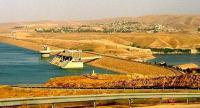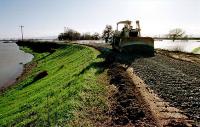-
After historic Texas flooding, officials will likely open more floodgates on Central Texas dam
Across Central Texas and the Hill Country, heavy rain has led to catastrophic flooding in the past week. With more rainfall in the forecast, state and local officials are working to manage floodwaters before they move downstream. After the wettest September in Texas history, multiple Central Texas reservoirs are completely full. That has forced officials to consider releasing a historic amount of water down the Colorado River.
-
-
Using Artificial Intelligence to locate risky dams
In the U.S., 15,498 of the more than 88,000 dams in the country are categorized as having high hazard potential—meaning that if they fail, they could kill people. As of 2015, some 2,000 of these high hazard dams are in need of repair. With a hefty price tag estimated at around $20 billion, those repairs aren’t going to happen overnight.
-
-
Using Artificial Intelligence to locate risky dams
In the U.S., 15,498 of the more than 88,000 dams in the country are categorized as having high hazard potential—meaning that if they fail, they could kill people. As of 2015, some 2,000 of these high hazard dams are in need of repair. With a hefty price tag estimated at around $20 billion, those repairs aren’t going to happen overnight.
-
-
Flood thy neighbor: Who stays dry and who decides?
When rivers flood now in the United States, the first towns to get hit are the unprotected ones right by the river. The last to go, if they flood at all, are the privileged few behind strong levees. While levees mostly are associated with large, low-lying cities such as New Orleans, a majority of the nation’s Corps-managed levees protect much smaller communities, rural farm towns and suburbs such as Valley Park. Missouri. Valley Park’s levee saga captures what’s wrong with America’s approach to controlling rivers.
-
-
Inside a secretive lobbying effort to deregulate federal levees
Nearly a year after record Midwestern floods killed at least five people and caused $1.7 billion in damage, a secretive lobbying effort funded by Illinois and Missouri drainage districts is underway to roll back flood regulations, documents show.
-
-
Dam simulation program saves lives, money
Have you ever wondered what happens when a dam fails? How fast and how far would all the water, which was being held back, reach? How long would it take to stop and just how deep would the flooding be? And, most importantly, how much damage would it cause to properties, infrastructures and the environment downstream from the dam? Not to mention the toll on human life. With more than 96,000 dams across the United States, those are the kind of questions dam safety engineers in state and government agencies and emergency managers must answer in order to prevent loss of life and to protect properties and critical infrastructures in case of a dam failure.
-
-
Miniaturizing America's tallest dam to prevent future disasters
Engineers at Utah State University’s Utah Water Research Laboratory have constructed a 1:50 scale model of the Oroville Dam spillway. The model will provide useful information about hydraulic conditions in and around the damaged spillway.
-
-
Oroville dam danger shows how Trump could win big on infrastructure
This near catastrophe at Oroville dam — America’s tallest dam — is just the latest symptom of the chronic ill-health of America’s civil infrastructure, which has suffered from decades of under-investment and neglect. But the Oroville dam crisis could provide an unexpected opportunity for the new Trump administration to take on both problems – and win. The main problem in dealing with U.S. infrastructure is money, as up to $1 trillion would be required to repair or replace ageing dams, bridges, highways, and all the other components that support modern civilization. But there is a way for Trump to harness market forces and persuade corporate investors to invest in U.S. infrastructure. The Oroville dam near catastrophe demonstrates that some of the largest imminent threats to infrastructure will increase through climate change, and provides compelling evidence of the hard economic costs of inaction on infrastructure. If Trump moves away from climate change denial and accepts the strong balance of scientific evidence and opinion about human contribution t climate change, then a pathway to dealing with U.S. infrastructure could open up by appealing to “natural capitalism” – a market-driven economics which centers on the value of natural resources. Accepting man-made climate change could provide Trump with a chance to deliver on one of his major campaign promises, change the face of capitalism, and perhaps even save the world along the way.
-
-
Many U.S. dams are obsolete, costly, aging, and unsafe
As is the case with much of America’s aging infrastructure, many of the country’s estimated two million dams are obsolete, costly, aging, and unsafe. Nearly 4,000 dams around the country have been reported as deficient, and the American Society of Civil Engineers has given America’s dam infrastructure a D rating. “It shouldn’t take a catastrophic failure for the dams in this country to get much-needed attention,” said the author of a new report. “Unfortunately, as is the case with much of our aging infrastructure, we jump from crisis to crisis and fail to plan ahead.”
-
-
Mosul dam could collapse at any time, killing 1m people: Engineers

Iraqi civil engineers familiar with the Mosul dam are warning of the dam’s imminent collapse, saying that the consequent death toll would likely be worse than earlier estimated. The engineers warned that the loss of life from a sudden collapse of the Mosul dam could be higher than earlier official estimates of 500,000, as many people could perish in the resulting mass panic. If the dam collapses, a 20-metre-high flood wave would hit the city of Mosul, then roll on down the Tigris valley through Tikrit and Samarra all the way to Baghdad.
-
-
Levees may make flood risk higher, not lower

People living behind levees on floodplains may not be as immune to flood damage as they think, according to results of a new study. U.S. floodplains are lined by more than 100,000 miles of levees, many of which are in questionable states of repair.
-
-
Redirected flood waters leading to unintended consequences

An intricate system of basins, channels, and levees called the Headwaters Diversion carries water from the eastern Missouri Ozark Plateau to the Mississippi River south of Cape Girardeau. The system protects 1.2 million acres of agricultural lands from both overflow from the Mississippi River during flooding events and from Ozark Plateau runoff. Climate scientists predict a continued pattern of extreme rainfall events in the upper Mississippi River region, suggesting that unexpected above average rainfall events in the Ohio and Mississippi River basins will continue to increase the frequency of extreme flooding events on these rivers.
-
-
California levees face risk of catastrophic failure as a result of historic drought

Earthen levees protect dry land from floods and function as water storage and management systems. Over 21,000 kilometers of earthen levees deliver approximately two-thirds of potable water to more than twenty-three million Californians and protect more than $47 billion worth of homes and businesses from flooding. Scientists say that the ongoing extreme drought in the state poses a risk of catastrophic failure to California’s levee systems and highlights an urgent need to invest in research regarding the vulnerabilities of these systems under extreme climatic events.
-
-
Resilient rivers respond quickly to dam removal
More than 1,000 dams have been removed across the United States because of safety concerns, sediment buildup, inefficiency, or having otherwise outlived usefulness. A paper published the other day finds that rivers are resilient and respond relatively quickly after a dam is removed. Studies show that most river channels stabilize within months or years, not decades, particularly when dams are removed rapidly.
-
-
International experts analyze impacts of Ethiopian dam
A new report addresses potential effects of huge construction project. According to present plans, the Grand Ethiopian Renaissance Dam (GERD) — now under construction across the Blue Nile River in Ethiopia — will be the largest hydroelectric dam in Africa, and one of the twelve largest in the world. But controversy has surrounded the project ever since it was announced in 2011 — especially concerning its possible effects on Sudan and Egypt, downstream nations that rely heavily on the waters of the Nile for agriculture, industry, and drinking water.
-
- All
- Regional
- Water
- Biometrics
- Borders/Immig
- Business
- Cybersecurity
- Detection
- Disasters
- Government
- Infrastructure
- International
- Public health
- Public Safety
- Communication interoperabillity
- Emergency services
- Emergency medical services
- Fire
- First response
- IEDs
- Law Enforcement
- Law Enforcement Technology
- Military technology
- Nonlethal weapons
- Nuclear weapons
- Personal protection equipment
- Police
- Notification /alert systems
- Situational awareness
- Weapons systems
- Sci-Tech
- Sector Reports
- Surveillance
- Transportation
Advertising & Marketing: advertise@newswirepubs.com
Editorial: editor@newswirepubs.com
General: info@newswirepubs.com
2010-2011 © News Wire Publications, LLC News Wire Publications, LLC
220 Old Country Road | Suite 200 | Mineola | New York | 11501
Permissions and Policies
Editorial: editor@newswirepubs.com
General: info@newswirepubs.com
2010-2011 © News Wire Publications, LLC News Wire Publications, LLC
220 Old Country Road | Suite 200 | Mineola | New York | 11501
Permissions and Policies
